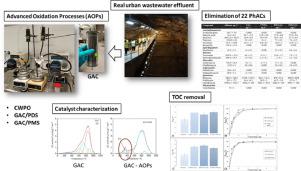Water Research ( IF 12.8 ) Pub Date : 2021-01-13 , DOI: 10.1016/j.watres.2021.116833 Juan José Rueda-Márquez , Javier Moreno-Andrés , Ana Rey , Carmen Corada-Fernández , Anna Mikola , Manuel A. Manzano , Irina Levchuk

|
Pharmaceutically active compounds (PhACs) widely present in urban wastewater effluents pose a threat to ecosystems in the receiving aquatic environment. In this work, efficiency of granular activated carbon (GAC) - based catalytic processes, namely catalytic wet peroxide oxidation (CWPO), peroxymonosulfate oxidation (PMS/GAC) and peroxydisulfate oxidation (PDS/GAC) at ambient temperature and pressure were studied for removal of 22 PhACs (ng L−1 level) that were present in secondary effluents of real urban wastewater. Concentrations of PhACs were measured using Ultra Performance Liquid Chromatography – Triple Quadrupole Mass Spectrometry (UPLC-QqQ-MS/MS). Catalytic experiments were conducted in discontinuous mode using up-flow fixed bed reactors with granular activated carbon (GAC) as a catalyst. The catalyst was characterized by means of N2 adsorption-desorption isotherm, mercury intrusion porosimetry (MIP), elemental analysis, X-ray fluorescence spectroscopy (WDXRF), X-ray diffraction (XRD), thermal gravimetry and differential temperature analyses coupled mass spectrometry (TGA-DTA-MS). Results indicate that the highest efficiency in terms of TOC removal was achieved during CWPO performed at optimal operational conditions (stoichiometric dose of H2O2; TOC removal ~ 82%) followed by PMS/GAC (initial PMS concentration 100 mg L−1; TOC removal ~73.7%) and PDS/GAC (initial PDS concentration 100 mg L−1; TOC removal ~ 67.9%) after 5 min of contact time. Full consumption of oxidants was observed in all cases for CWPO and PDS/GAC at contact times of 2.5 min, while for PMS/GAC it was 1.5 min. In general, for 18 out of 22 target PhACs, very high removal efficiencies (> 92%) were achieved in all tested processes (including adsorption) performed at optimal operational conditions during 5 min of contact time. However, moderate (40 – 70%) and poor (< 40%) removal efficiencies were achieved for salicylic acid, ofloxacin, norfloxacin and ciprofloxacin, which can be possibly attributed to insufficient contact time. Despite high efficiency of all studied processes for PhACs elimination from urban wastewater effluent, CWPO seems to be more promising for continuous operation.
中文翻译:

通过基于颗粒活性炭(GAC)的催化工艺对实际市政废水进行后处理:重点在于减少药物活性化合物
广泛存在于城市废水中的药物活性化合物(PhAC)对接收水生环境中的生态系统构成了威胁。在这项工作中,研究了在室温和常压下基于颗粒活性炭(GAC)的催化工艺的效率,即催化湿式过氧化物氧化(CWPO),过氧化一硫酸盐氧化(PMS / GAC)和过氧化二硫酸盐氧化(PDS / GAC)的去除效果。 22 PhAC(ng L -1水平)存在于实际城市污水的二次排放中。使用超高效液相色谱-三重四极杆质谱(UPLC-QqQ-MS / MS)测量PhAC的浓度。使用颗粒活性炭(GAC)作为催化剂的上流式固定床反应器,以不连续模式进行催化实验。通过N 2吸附-脱附等温线,压汞法(MIP),元素分析,X射线荧光光谱(WDXRF),X射线衍射(XRD),热重分析和差温分析耦合质谱对催化剂进行了表征。(TGA-DTA-MS)。结果表明,在最佳操作条件下(H的化学计量剂量)执行CWPO时,TOC去除效率最高。2 O 2 ; TOC去除率〜82%),然后是PMS / GAC(初始PMS浓度为100 mg L -1 ; TOC去除率〜73.7%)和PDS / GAC(初始PDS浓度为100 mg L -1; 接触时间5分钟后,TOC去除率约为67.9%。在所有情况下,对于CWPO和PDS / GAC,在接触时间为2.5分钟时都观察到氧化剂完全消耗,而对于PMS / GAC,则为1.5分钟。通常,对于22种目标PhAC中的18种,在5分钟的接触时间内以最佳操作条件进行的所有测试过程(包括吸附)均实现了很高的去除效率(> 92%)。但是,水杨酸,氧氟沙星,诺氟沙星和环丙沙星的去除效率中等(40 – 70%)和差(<40%),这可能归因于接触时间不足。尽管所有研究的方法都能有效去除城市废水中的PhAC,但CWPO似乎对于连续运行更具前景。


























 京公网安备 11010802027423号
京公网安备 11010802027423号